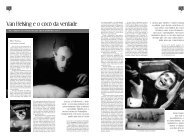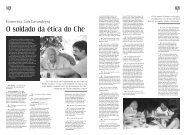Merleau-Ponty, 1964. Eye and mind. - Biolinguagem
Merleau-Ponty, 1964. Eye and mind. - Biolinguagem
Merleau-Ponty, 1964. Eye and mind. - Biolinguagem
- No tags were found...
Create successful ePaper yourself
Turn your PDF publications into a flip-book with our unique Google optimized e-Paper software.
IV<br />
The entire history of painting in the modern period, with its efforts to detach itself from<br />
illusionism <strong>and</strong> acquire its own dimensions, has a metaphysical significance. There can<br />
be no question of demonstrating this here. Not because of the limits of objectivity in<br />
history <strong>and</strong> the inevitable plurality of interpretations, which would forbid linking a<br />
philosophy <strong>and</strong> an event, for the metaphysics we have in <strong>mind</strong> is not a separate body of<br />
ideas for which inductive justifications could then be sought in the experiential realm—<br />
<strong>and</strong> there are, in the flesh of contingency, a structure of the event <strong>and</strong> a virtue peculiar to<br />
the scenario that do not prevent the plurality of interpretations but in fact are the deepest<br />
reason for it. They make the event a durable theme of historical life, <strong>and</strong> have a right to<br />
philosophical status. In a sense everything that may have been said <strong>and</strong> will be said<br />
about the French Revolution has always been <strong>and</strong> will henceforth be within it, in that<br />
wave arising from a roil of discrete facts, with its froth of the past <strong>and</strong> its crest of the<br />
future. And it is always by looking more deeply into how it came about that we make <strong>and</strong><br />
will go on making new representations of it. As for the history of works of art, in any case,<br />
if they are great, the sense we give to them later on has issued from them. It is the work<br />
itself that has opened the perspective from which it appears in another light. It transforms<br />
itself <strong>and</strong> becomes what follows; the interminable interpretations to which it is legitimately<br />
susceptible change it only into itself. And if the historian unearths beneath its manifest<br />
content a surplus <strong>and</strong> thickness of meaning, a texture which held the promise of a long<br />
history, then this active manner of being, this possibility he unveils in the work, this<br />
monogram he finds there—all are grounds for a philosophical meditation. But such a<br />
labor dem<strong>and</strong>s a long familiarity with history. I lack everything for its execution, both<br />
competence <strong>and</strong> space. But since the power or the fecundity of works of art exceeds<br />
every positive causal or linear relation, it is not illegitimate for a layman such as myself,<br />
speaking from his memory of a few paintings <strong>and</strong> books, to express how painting enters<br />
into his reflections, <strong>and</strong> to register his sense of a profound dissonance, a transformation<br />
in the relationship between humanity <strong>and</strong> Being, when he holds up a universe of classical<br />
thought, contrasting it en bloc with the explorations of modern painting. A sort of history<br />
by contact, that perhaps does not go beyond the limits of one person, though it owes<br />
everything to his frequentation of others….<br />
"I believe Cézanne was seeking depth all his life," says Giacometti. 34 Says Robert<br />
Delaunay, "Depth is the new inspiration. " 35 Four centuries after the "solutions" of the<br />
Renaissance <strong>and</strong> three centuries after Descartes, depth is still new, <strong>and</strong> it insists on<br />
being sought, not "once in a lifetime" but all through life. It cannot be merely a question of<br />
an unmysterious interval, as seen from an airplane, between these trees nearby <strong>and</strong><br />
those farther away. Nor is it a matter of the way things are conjured away, one by<br />
another, as we see so vividly portrayed in a perspective drawing. These two views are<br />
very explicit <strong>and</strong> raise no problems. The enigma, though, lies in their bond, in what is<br />
between them. The enigma consists in the fact that I see things, each one in its place,<br />
precisely because they eclipse one another, <strong>and</strong> that they are rivals before my sight<br />
precisely because each one is in its own place—in their exteriority, known through their<br />
envelopment, <strong>and</strong> their mutual dependence in their autonomy. Once depth is understood<br />
in this way, we can . no longer call it a third dimension. In the first place, if it were a<br />
dimension, it would be the first one; there are forms <strong>and</strong> definite planes only if it is<br />
stipulated how far from me their different parts are. But a first dimension that contains all<br />
the others is no longer a dimension, at least in the ordinary sense of a certain relationship<br />
according to which we make measurements. Depth thus understood is, rather, the<br />
experience of the reversibility of dimensions, of a global "locality" in which everything is in<br />
the same place at the same time, a locality from which height, width, <strong>and</strong> depth are<br />
abstracted, a voluminosity we express in a word when we say that a thing is there. In<br />
13









